Analysis of International Trade, Investment, and Finance in China
VerifiedAdded on 2022/12/30
|17
|4006
|2
Report
AI Summary
This report delves into the realm of international trade, investment, and finance, with a specific focus on the economic dynamics between the United Kingdom and China. It begins with an executive summary and an introduction that sets the stage for an in-depth analysis of the financial market backgrounds in both countries. The report evaluates the economic landscape, including capital allocation within domestic and global markets, and critically assesses the challenges stemming from industrialization and trade policies. It provides detailed examinations of key financial institutions, such as the Shanghai and Shenzhen Stock Exchanges, interbank markets, repo markets, and OTC markets. The report then discusses challenges faced by China due to industrialization and trade policies, including falling economic growth rates, regional imbalances, and issues related to export-driven economies. The report concludes with recommendations aimed at enhancing international trade and finance, supported by relevant references.
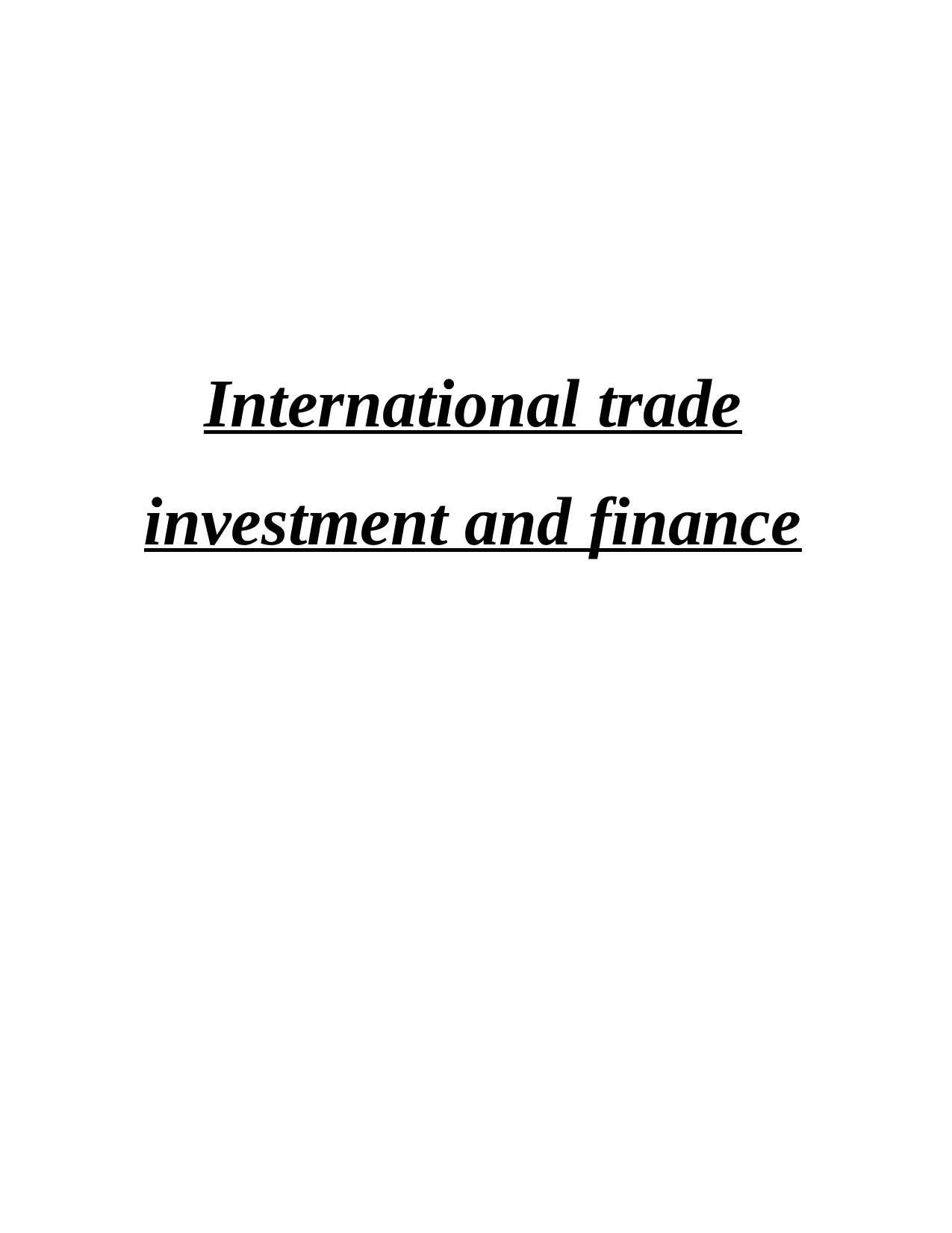
International trade
investment and finance
investment and finance
Paraphrase This Document
Need a fresh take? Get an instant paraphrase of this document with our AI Paraphraser
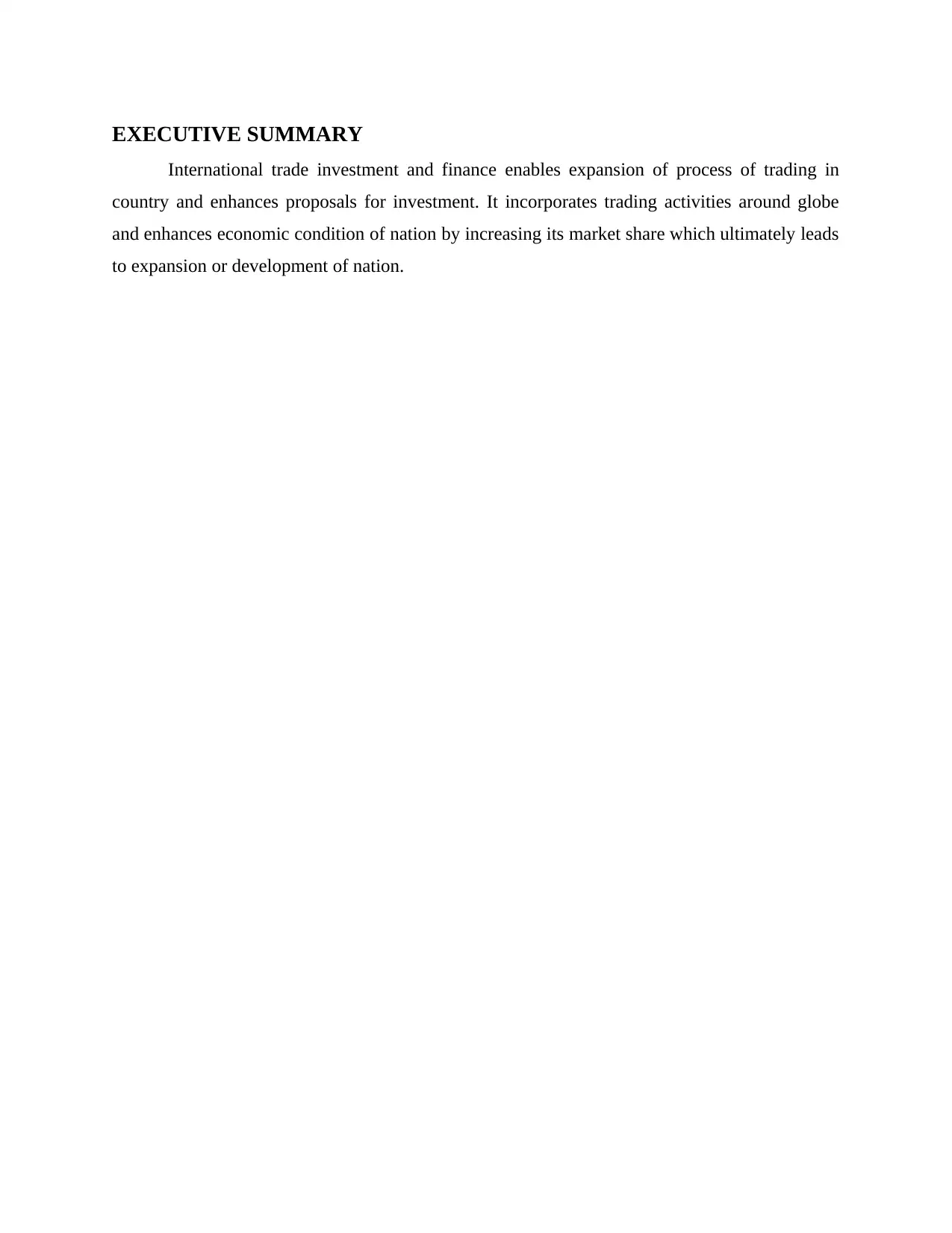
EXECUTIVE SUMMARY
International trade investment and finance enables expansion of process of trading in
country and enhances proposals for investment. It incorporates trading activities around globe
and enhances economic condition of nation by increasing its market share which ultimately leads
to expansion or development of nation.
International trade investment and finance enables expansion of process of trading in
country and enhances proposals for investment. It incorporates trading activities around globe
and enhances economic condition of nation by increasing its market share which ultimately leads
to expansion or development of nation.
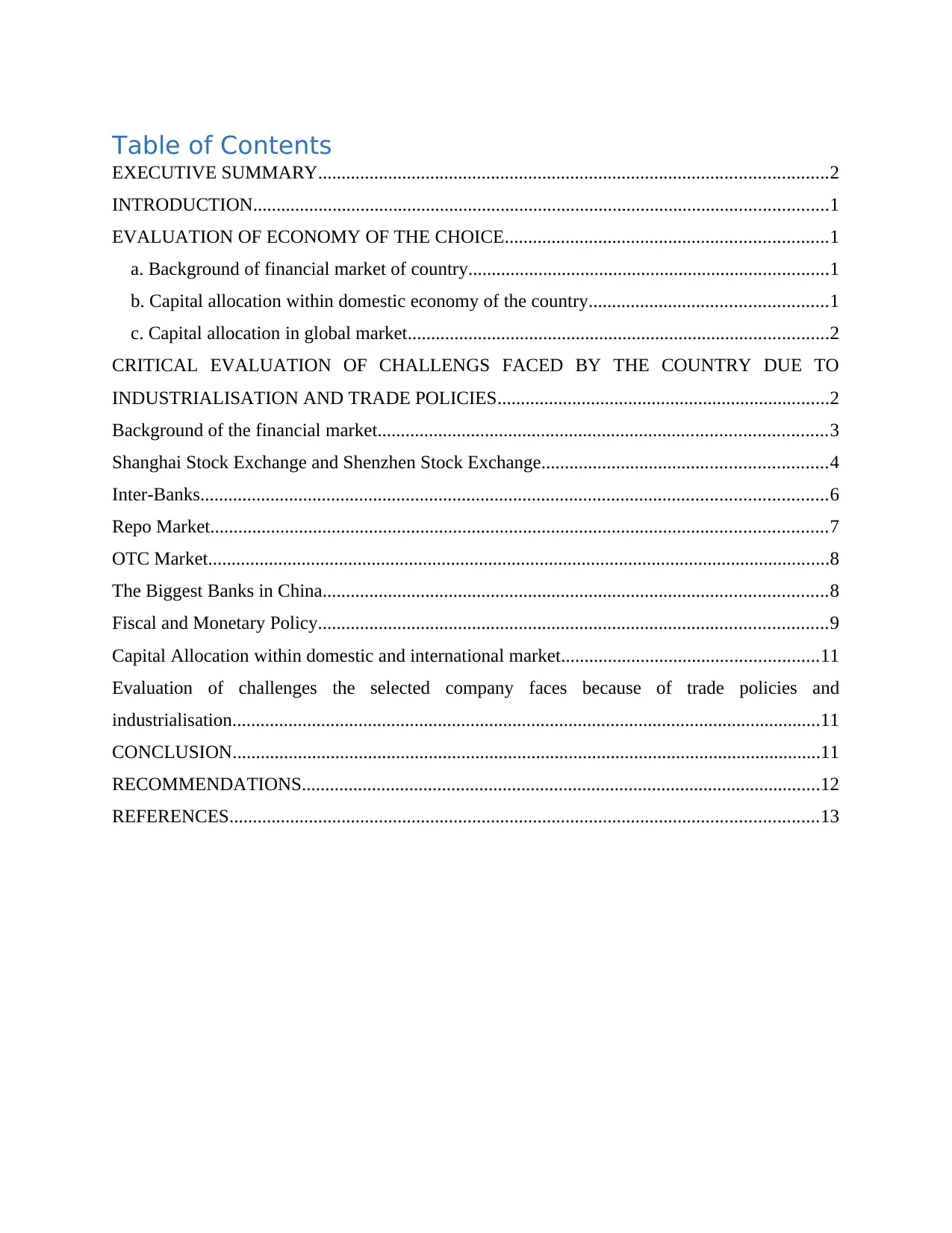
Table of Contents
EXECUTIVE SUMMARY.............................................................................................................2
INTRODUCTION...........................................................................................................................1
EVALUATION OF ECONOMY OF THE CHOICE.....................................................................1
a. Background of financial market of country.............................................................................1
b. Capital allocation within domestic economy of the country...................................................1
c. Capital allocation in global market..........................................................................................2
CRITICAL EVALUATION OF CHALLENGS FACED BY THE COUNTRY DUE TO
INDUSTRIALISATION AND TRADE POLICIES.......................................................................2
Background of the financial market................................................................................................3
Shanghai Stock Exchange and Shenzhen Stock Exchange.............................................................4
Inter-Banks......................................................................................................................................6
Repo Market....................................................................................................................................7
OTC Market.....................................................................................................................................8
The Biggest Banks in China............................................................................................................8
Fiscal and Monetary Policy.............................................................................................................9
Capital Allocation within domestic and international market.......................................................11
Evaluation of challenges the selected company faces because of trade policies and
industrialisation..............................................................................................................................11
CONCLUSION..............................................................................................................................11
RECOMMENDATIONS...............................................................................................................12
REFERENCES..............................................................................................................................13
EXECUTIVE SUMMARY.............................................................................................................2
INTRODUCTION...........................................................................................................................1
EVALUATION OF ECONOMY OF THE CHOICE.....................................................................1
a. Background of financial market of country.............................................................................1
b. Capital allocation within domestic economy of the country...................................................1
c. Capital allocation in global market..........................................................................................2
CRITICAL EVALUATION OF CHALLENGS FACED BY THE COUNTRY DUE TO
INDUSTRIALISATION AND TRADE POLICIES.......................................................................2
Background of the financial market................................................................................................3
Shanghai Stock Exchange and Shenzhen Stock Exchange.............................................................4
Inter-Banks......................................................................................................................................6
Repo Market....................................................................................................................................7
OTC Market.....................................................................................................................................8
The Biggest Banks in China............................................................................................................8
Fiscal and Monetary Policy.............................................................................................................9
Capital Allocation within domestic and international market.......................................................11
Evaluation of challenges the selected company faces because of trade policies and
industrialisation..............................................................................................................................11
CONCLUSION..............................................................................................................................11
RECOMMENDATIONS...............................................................................................................12
REFERENCES..............................................................................................................................13
⊘ This is a preview!⊘
Do you want full access?
Subscribe today to unlock all pages.

Trusted by 1+ million students worldwide
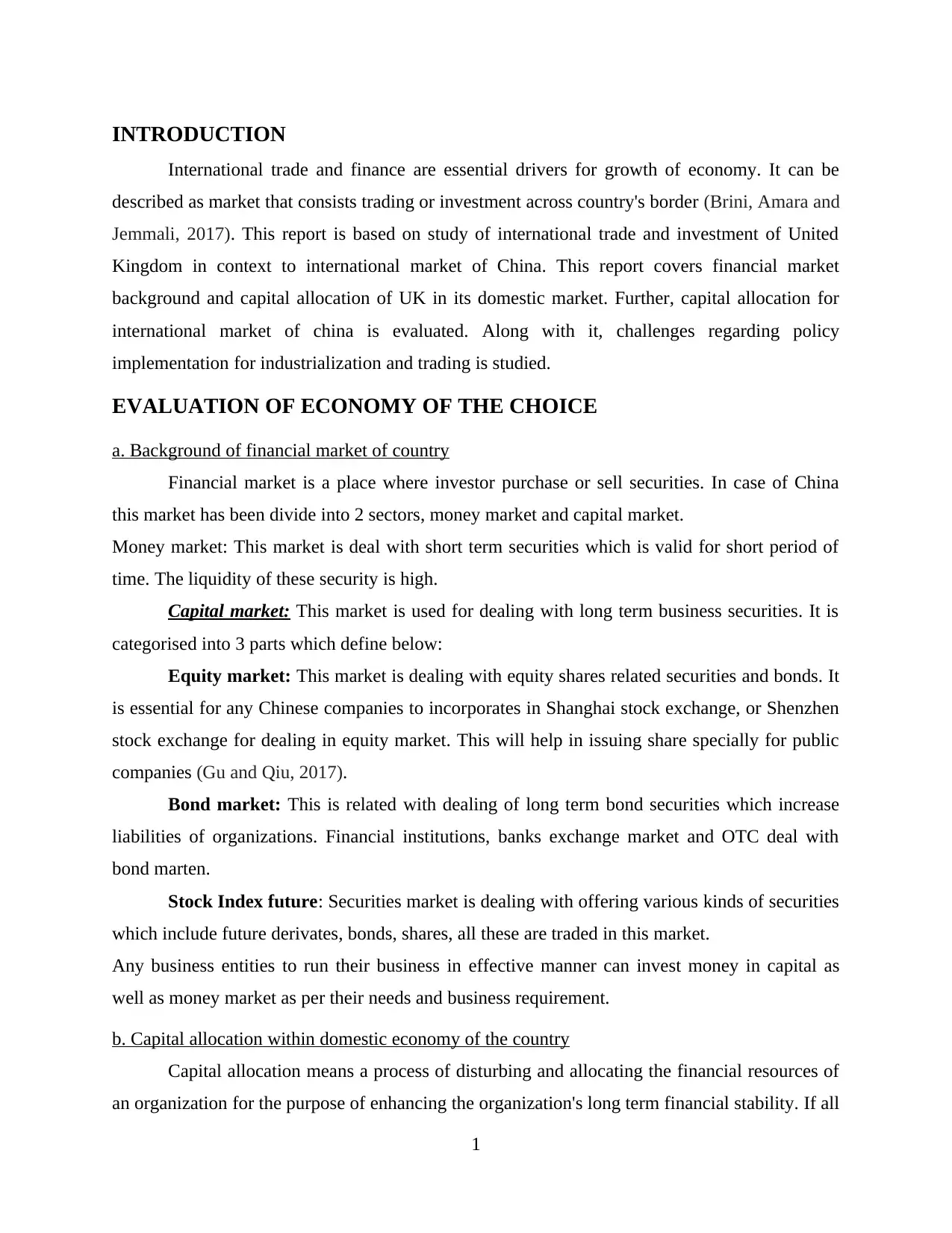
INTRODUCTION
International trade and finance are essential drivers for growth of economy. It can be
described as market that consists trading or investment across country's border (Brini, Amara and
Jemmali, 2017). This report is based on study of international trade and investment of United
Kingdom in context to international market of China. This report covers financial market
background and capital allocation of UK in its domestic market. Further, capital allocation for
international market of china is evaluated. Along with it, challenges regarding policy
implementation for industrialization and trading is studied.
EVALUATION OF ECONOMY OF THE CHOICE
a. Background of financial market of country
Financial market is a place where investor purchase or sell securities. In case of China
this market has been divide into 2 sectors, money market and capital market.
Money market: This market is deal with short term securities which is valid for short period of
time. The liquidity of these security is high.
Capital market: This market is used for dealing with long term business securities. It is
categorised into 3 parts which define below:
Equity market: This market is dealing with equity shares related securities and bonds. It
is essential for any Chinese companies to incorporates in Shanghai stock exchange, or Shenzhen
stock exchange for dealing in equity market. This will help in issuing share specially for public
companies (Gu and Qiu, 2017).
Bond market: This is related with dealing of long term bond securities which increase
liabilities of organizations. Financial institutions, banks exchange market and OTC deal with
bond marten.
Stock Index future: Securities market is dealing with offering various kinds of securities
which include future derivates, bonds, shares, all these are traded in this market.
Any business entities to run their business in effective manner can invest money in capital as
well as money market as per their needs and business requirement.
b. Capital allocation within domestic economy of the country
Capital allocation means a process of disturbing and allocating the financial resources of
an organization for the purpose of enhancing the organization's long term financial stability. If all
1
International trade and finance are essential drivers for growth of economy. It can be
described as market that consists trading or investment across country's border (Brini, Amara and
Jemmali, 2017). This report is based on study of international trade and investment of United
Kingdom in context to international market of China. This report covers financial market
background and capital allocation of UK in its domestic market. Further, capital allocation for
international market of china is evaluated. Along with it, challenges regarding policy
implementation for industrialization and trading is studied.
EVALUATION OF ECONOMY OF THE CHOICE
a. Background of financial market of country
Financial market is a place where investor purchase or sell securities. In case of China
this market has been divide into 2 sectors, money market and capital market.
Money market: This market is deal with short term securities which is valid for short period of
time. The liquidity of these security is high.
Capital market: This market is used for dealing with long term business securities. It is
categorised into 3 parts which define below:
Equity market: This market is dealing with equity shares related securities and bonds. It
is essential for any Chinese companies to incorporates in Shanghai stock exchange, or Shenzhen
stock exchange for dealing in equity market. This will help in issuing share specially for public
companies (Gu and Qiu, 2017).
Bond market: This is related with dealing of long term bond securities which increase
liabilities of organizations. Financial institutions, banks exchange market and OTC deal with
bond marten.
Stock Index future: Securities market is dealing with offering various kinds of securities
which include future derivates, bonds, shares, all these are traded in this market.
Any business entities to run their business in effective manner can invest money in capital as
well as money market as per their needs and business requirement.
b. Capital allocation within domestic economy of the country
Capital allocation means a process of disturbing and allocating the financial resources of
an organization for the purpose of enhancing the organization's long term financial stability. If all
1
Paraphrase This Document
Need a fresh take? Get an instant paraphrase of this document with our AI Paraphraser
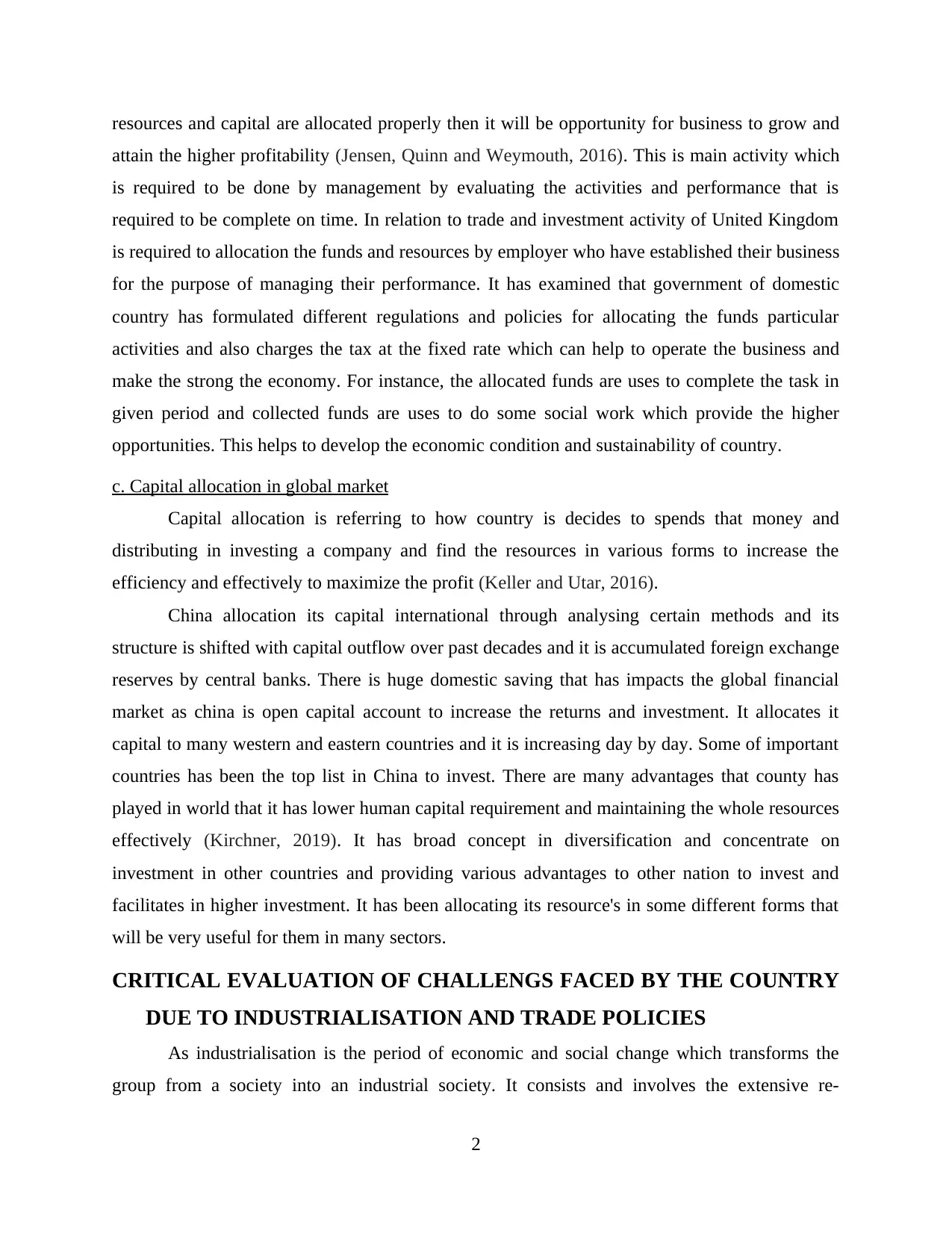
resources and capital are allocated properly then it will be opportunity for business to grow and
attain the higher profitability (Jensen, Quinn and Weymouth, 2016). This is main activity which
is required to be done by management by evaluating the activities and performance that is
required to be complete on time. In relation to trade and investment activity of United Kingdom
is required to allocation the funds and resources by employer who have established their business
for the purpose of managing their performance. It has examined that government of domestic
country has formulated different regulations and policies for allocating the funds particular
activities and also charges the tax at the fixed rate which can help to operate the business and
make the strong the economy. For instance, the allocated funds are uses to complete the task in
given period and collected funds are uses to do some social work which provide the higher
opportunities. This helps to develop the economic condition and sustainability of country.
c. Capital allocation in global market
Capital allocation is referring to how country is decides to spends that money and
distributing in investing a company and find the resources in various forms to increase the
efficiency and effectively to maximize the profit (Keller and Utar, 2016).
China allocation its capital international through analysing certain methods and its
structure is shifted with capital outflow over past decades and it is accumulated foreign exchange
reserves by central banks. There is huge domestic saving that has impacts the global financial
market as china is open capital account to increase the returns and investment. It allocates it
capital to many western and eastern countries and it is increasing day by day. Some of important
countries has been the top list in China to invest. There are many advantages that county has
played in world that it has lower human capital requirement and maintaining the whole resources
effectively (Kirchner, 2019). It has broad concept in diversification and concentrate on
investment in other countries and providing various advantages to other nation to invest and
facilitates in higher investment. It has been allocating its resource's in some different forms that
will be very useful for them in many sectors.
CRITICAL EVALUATION OF CHALLENGS FACED BY THE COUNTRY
DUE TO INDUSTRIALISATION AND TRADE POLICIES
As industrialisation is the period of economic and social change which transforms the
group from a society into an industrial society. It consists and involves the extensive re-
2
attain the higher profitability (Jensen, Quinn and Weymouth, 2016). This is main activity which
is required to be done by management by evaluating the activities and performance that is
required to be complete on time. In relation to trade and investment activity of United Kingdom
is required to allocation the funds and resources by employer who have established their business
for the purpose of managing their performance. It has examined that government of domestic
country has formulated different regulations and policies for allocating the funds particular
activities and also charges the tax at the fixed rate which can help to operate the business and
make the strong the economy. For instance, the allocated funds are uses to complete the task in
given period and collected funds are uses to do some social work which provide the higher
opportunities. This helps to develop the economic condition and sustainability of country.
c. Capital allocation in global market
Capital allocation is referring to how country is decides to spends that money and
distributing in investing a company and find the resources in various forms to increase the
efficiency and effectively to maximize the profit (Keller and Utar, 2016).
China allocation its capital international through analysing certain methods and its
structure is shifted with capital outflow over past decades and it is accumulated foreign exchange
reserves by central banks. There is huge domestic saving that has impacts the global financial
market as china is open capital account to increase the returns and investment. It allocates it
capital to many western and eastern countries and it is increasing day by day. Some of important
countries has been the top list in China to invest. There are many advantages that county has
played in world that it has lower human capital requirement and maintaining the whole resources
effectively (Kirchner, 2019). It has broad concept in diversification and concentrate on
investment in other countries and providing various advantages to other nation to invest and
facilitates in higher investment. It has been allocating its resource's in some different forms that
will be very useful for them in many sectors.
CRITICAL EVALUATION OF CHALLENGS FACED BY THE COUNTRY
DUE TO INDUSTRIALISATION AND TRADE POLICIES
As industrialisation is the period of economic and social change which transforms the
group from a society into an industrial society. It consists and involves the extensive re-
2
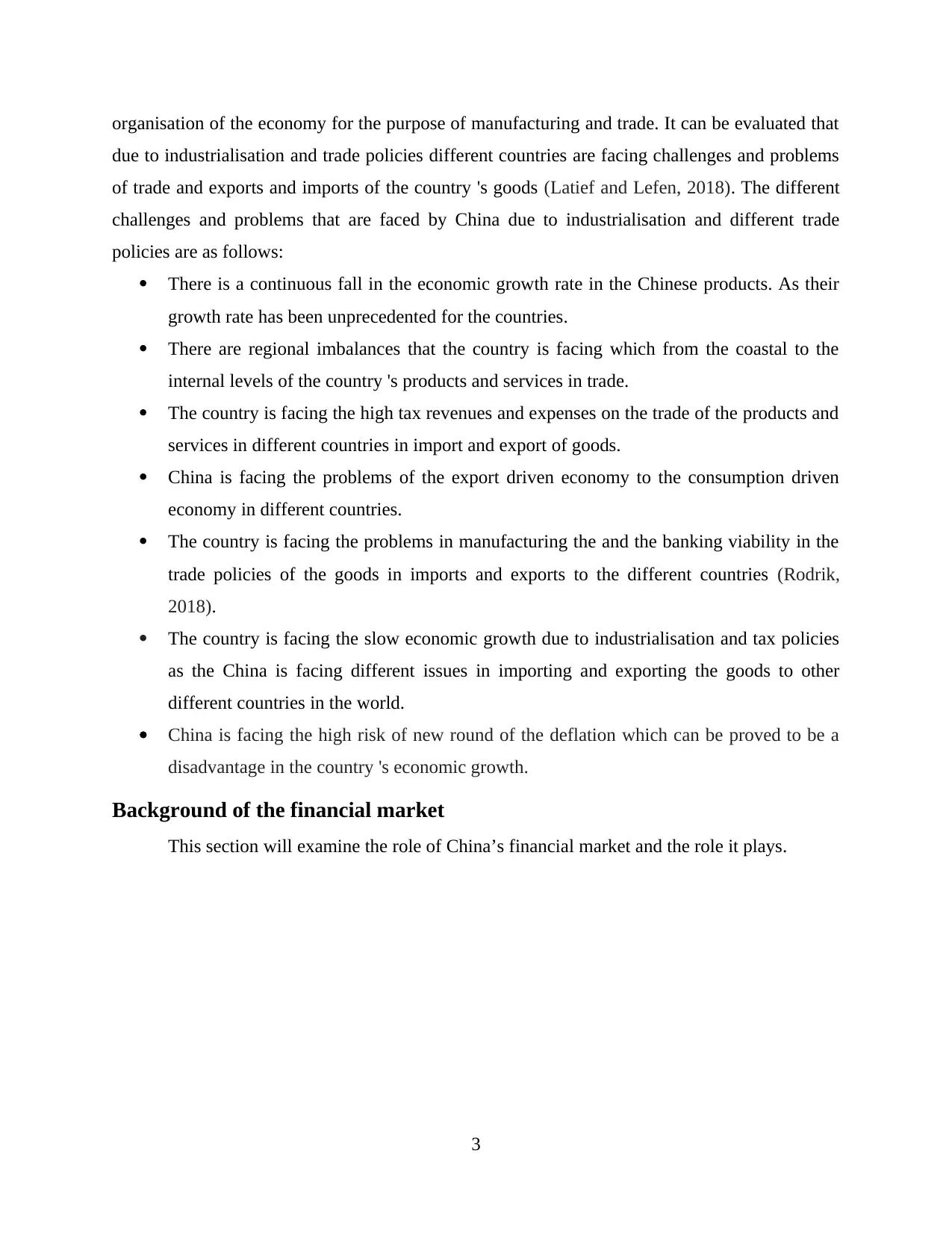
organisation of the economy for the purpose of manufacturing and trade. It can be evaluated that
due to industrialisation and trade policies different countries are facing challenges and problems
of trade and exports and imports of the country 's goods (Latief and Lefen, 2018). The different
challenges and problems that are faced by China due to industrialisation and different trade
policies are as follows:
There is a continuous fall in the economic growth rate in the Chinese products. As their
growth rate has been unprecedented for the countries.
There are regional imbalances that the country is facing which from the coastal to the
internal levels of the country 's products and services in trade.
The country is facing the high tax revenues and expenses on the trade of the products and
services in different countries in import and export of goods.
China is facing the problems of the export driven economy to the consumption driven
economy in different countries.
The country is facing the problems in manufacturing the and the banking viability in the
trade policies of the goods in imports and exports to the different countries (Rodrik,
2018).
The country is facing the slow economic growth due to industrialisation and tax policies
as the China is facing different issues in importing and exporting the goods to other
different countries in the world.
China is facing the high risk of new round of the deflation which can be proved to be a
disadvantage in the country 's economic growth.
Background of the financial market
This section will examine the role of China’s financial market and the role it plays.
3
due to industrialisation and trade policies different countries are facing challenges and problems
of trade and exports and imports of the country 's goods (Latief and Lefen, 2018). The different
challenges and problems that are faced by China due to industrialisation and different trade
policies are as follows:
There is a continuous fall in the economic growth rate in the Chinese products. As their
growth rate has been unprecedented for the countries.
There are regional imbalances that the country is facing which from the coastal to the
internal levels of the country 's products and services in trade.
The country is facing the high tax revenues and expenses on the trade of the products and
services in different countries in import and export of goods.
China is facing the problems of the export driven economy to the consumption driven
economy in different countries.
The country is facing the problems in manufacturing the and the banking viability in the
trade policies of the goods in imports and exports to the different countries (Rodrik,
2018).
The country is facing the slow economic growth due to industrialisation and tax policies
as the China is facing different issues in importing and exporting the goods to other
different countries in the world.
China is facing the high risk of new round of the deflation which can be proved to be a
disadvantage in the country 's economic growth.
Background of the financial market
This section will examine the role of China’s financial market and the role it plays.
3
⊘ This is a preview!⊘
Do you want full access?
Subscribe today to unlock all pages.

Trusted by 1+ million students worldwide
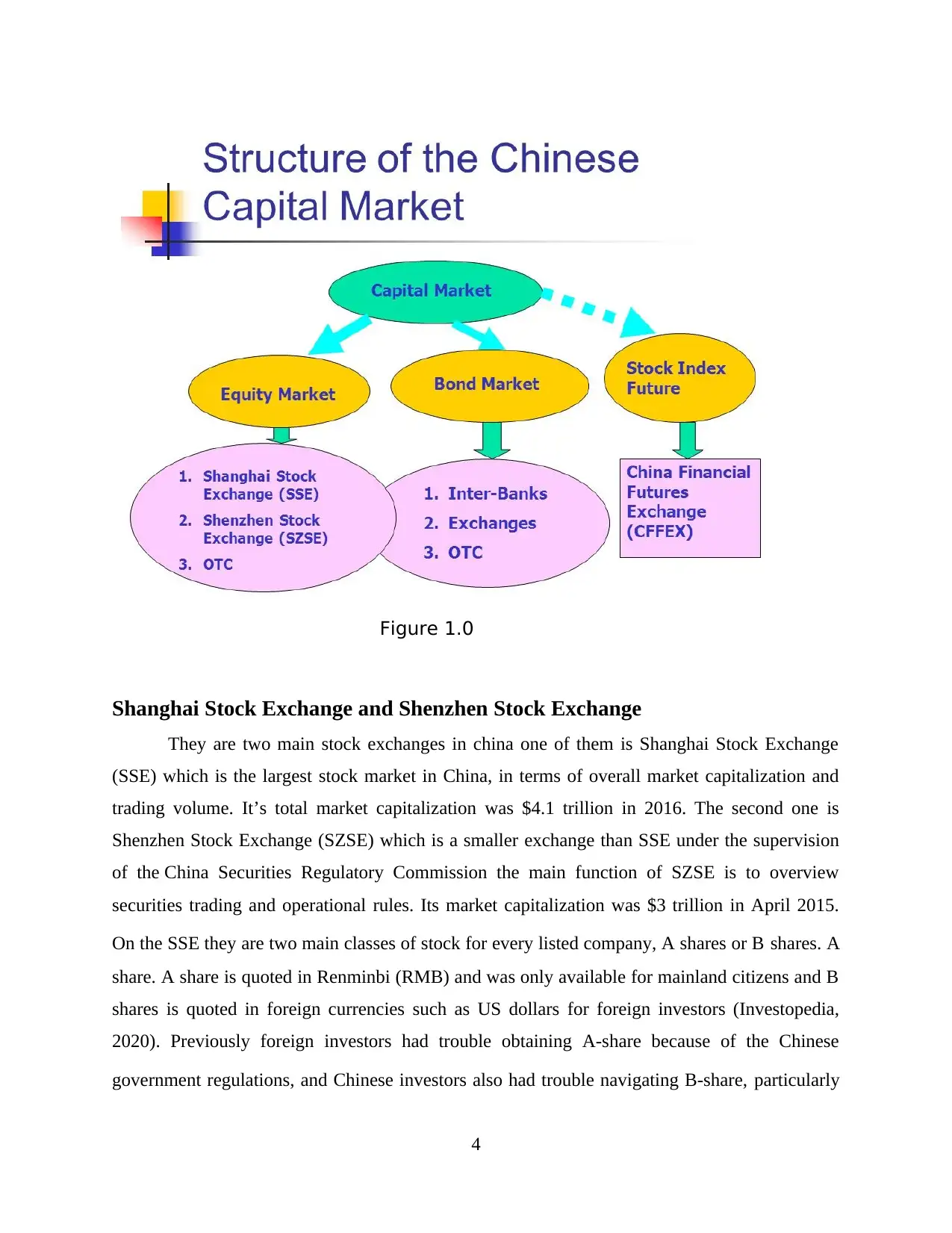
Figure 1.0
Shanghai Stock Exchange and Shenzhen Stock Exchange
They are two main stock exchanges in china one of them is Shanghai Stock Exchange
(SSE) which is the largest stock market in China, in terms of overall market capitalization and
trading volume. It’s total market capitalization was $4.1 trillion in 2016. The second one is
Shenzhen Stock Exchange (SZSE) which is a smaller exchange than SSE under the supervision
of the China Securities Regulatory Commission the main function of SZSE is to overview
securities trading and operational rules. Its market capitalization was $3 trillion in April 2015.
On the SSE they are two main classes of stock for every listed company, A shares or B shares. A
share. A share is quoted in Renminbi (RMB) and was only available for mainland citizens and B
shares is quoted in foreign currencies such as US dollars for foreign investors (Investopedia,
2020). Previously foreign investors had trouble obtaining A-share because of the Chinese
government regulations, and Chinese investors also had trouble navigating B-share, particularly
4
Shanghai Stock Exchange and Shenzhen Stock Exchange
They are two main stock exchanges in china one of them is Shanghai Stock Exchange
(SSE) which is the largest stock market in China, in terms of overall market capitalization and
trading volume. It’s total market capitalization was $4.1 trillion in 2016. The second one is
Shenzhen Stock Exchange (SZSE) which is a smaller exchange than SSE under the supervision
of the China Securities Regulatory Commission the main function of SZSE is to overview
securities trading and operational rules. Its market capitalization was $3 trillion in April 2015.
On the SSE they are two main classes of stock for every listed company, A shares or B shares. A
share. A share is quoted in Renminbi (RMB) and was only available for mainland citizens and B
shares is quoted in foreign currencies such as US dollars for foreign investors (Investopedia,
2020). Previously foreign investors had trouble obtaining A-share because of the Chinese
government regulations, and Chinese investors also had trouble navigating B-share, particularly
4
Paraphrase This Document
Need a fresh take? Get an instant paraphrase of this document with our AI Paraphraser
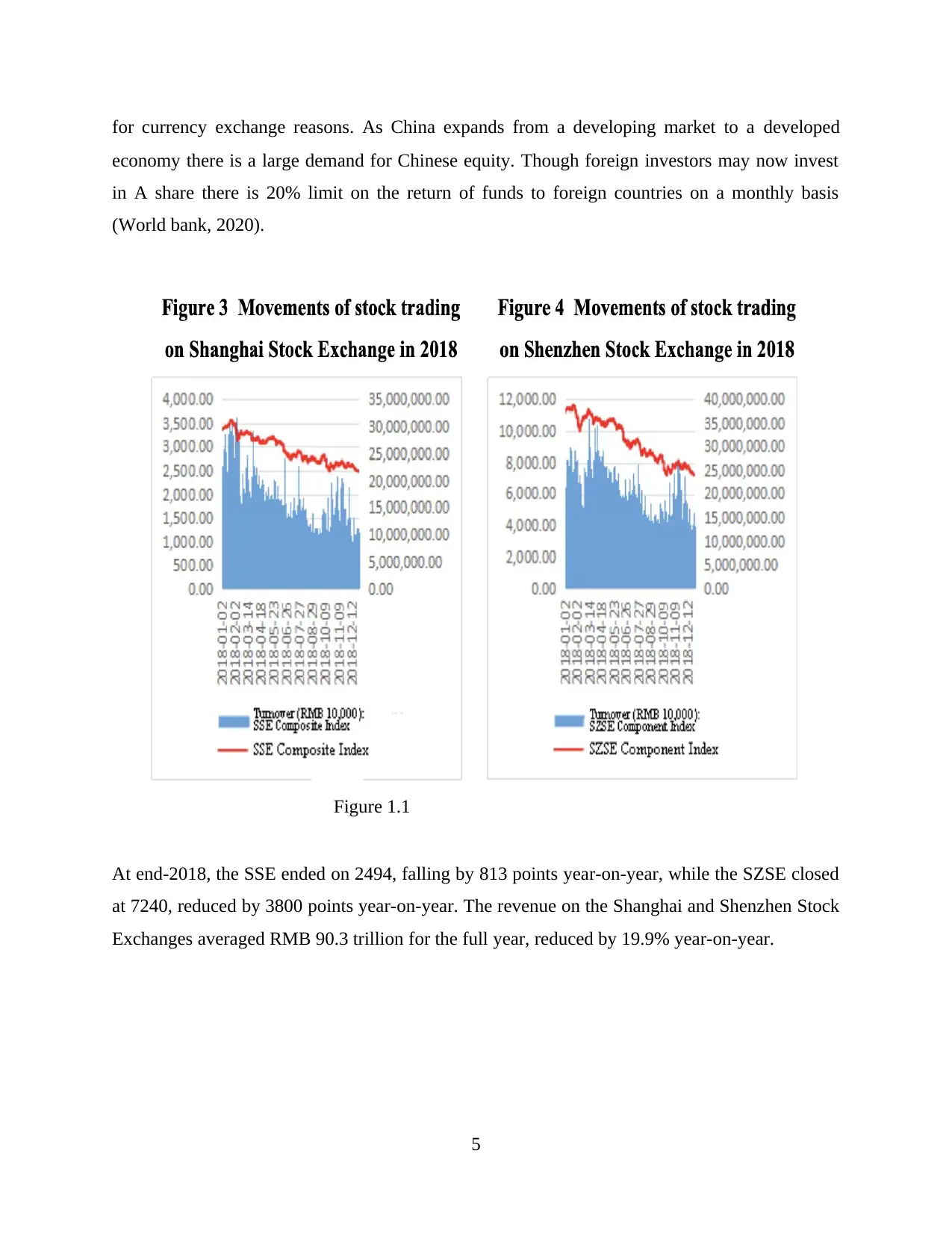
for currency exchange reasons. As China expands from a developing market to a developed
economy there is a large demand for Chinese equity. Though foreign investors may now invest
in A share there is 20% limit on the return of funds to foreign countries on a monthly basis
(World bank, 2020).
Figure 1.1
At end-2018, the SSE ended on 2494, falling by 813 points year-on-year, while the SZSE closed
at 7240, reduced by 3800 points year-on-year. The revenue on the Shanghai and Shenzhen Stock
Exchanges averaged RMB 90.3 trillion for the full year, reduced by 19.9% year-on-year.
5
economy there is a large demand for Chinese equity. Though foreign investors may now invest
in A share there is 20% limit on the return of funds to foreign countries on a monthly basis
(World bank, 2020).
Figure 1.1
At end-2018, the SSE ended on 2494, falling by 813 points year-on-year, while the SZSE closed
at 7240, reduced by 3800 points year-on-year. The revenue on the Shanghai and Shenzhen Stock
Exchanges averaged RMB 90.3 trillion for the full year, reduced by 19.9% year-on-year.
5
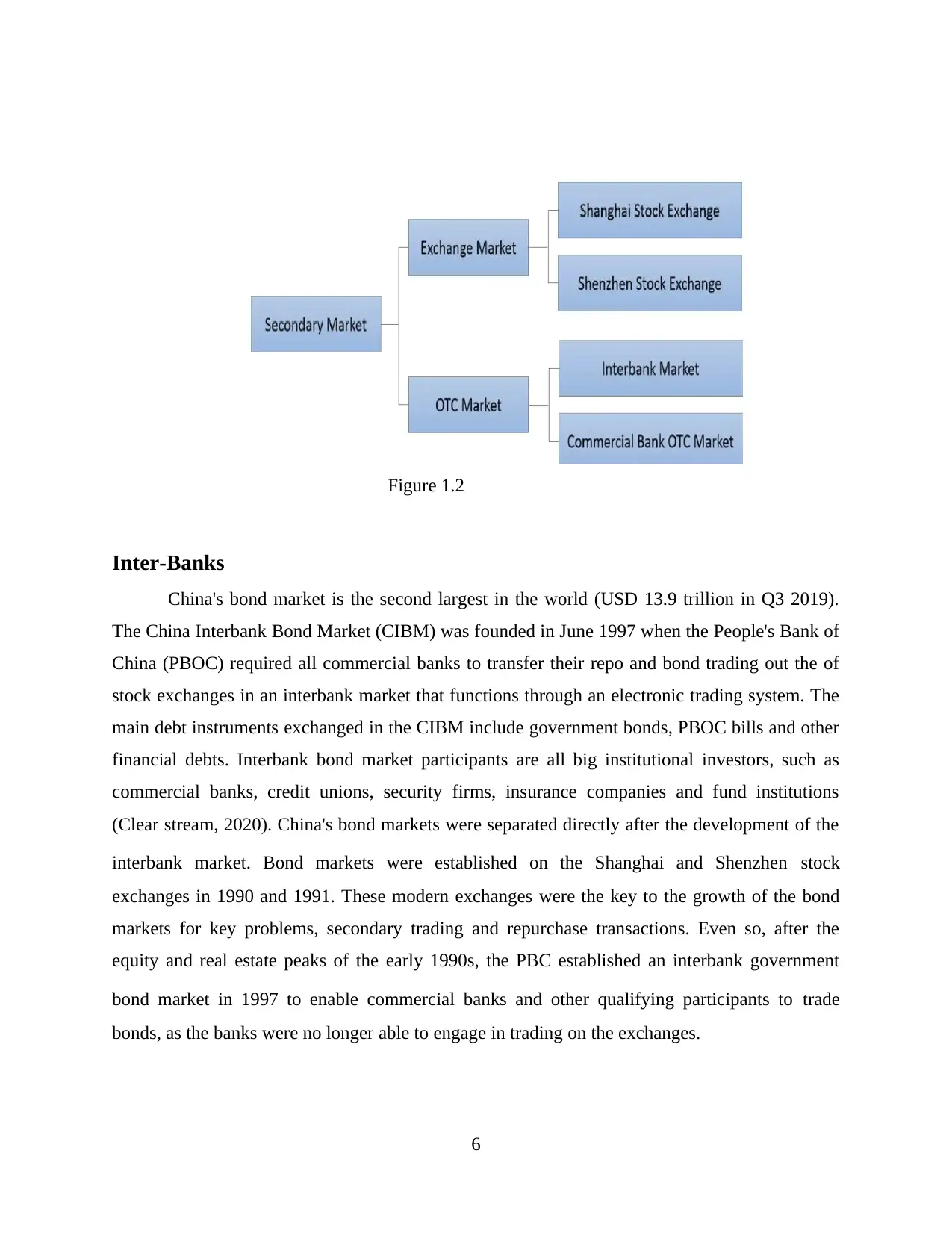
Figure 1.2
Inter-Banks
China's bond market is the second largest in the world (USD 13.9 trillion in Q3 2019).
The China Interbank Bond Market (CIBM) was founded in June 1997 when the People's Bank of
China (PBOC) required all commercial banks to transfer their repo and bond trading out the of
stock exchanges in an interbank market that functions through an electronic trading system. The
main debt instruments exchanged in the CIBM include government bonds, PBOC bills and other
financial debts. Interbank bond market participants are all big institutional investors, such as
commercial banks, credit unions, security firms, insurance companies and fund institutions
(Clear stream, 2020). China's bond markets were separated directly after the development of the
interbank market. Bond markets were established on the Shanghai and Shenzhen stock
exchanges in 1990 and 1991. These modern exchanges were the key to the growth of the bond
markets for key problems, secondary trading and repurchase transactions. Even so, after the
equity and real estate peaks of the early 1990s, the PBC established an interbank government
bond market in 1997 to enable commercial banks and other qualifying participants to trade
bonds, as the banks were no longer able to engage in trading on the exchanges.
6
Inter-Banks
China's bond market is the second largest in the world (USD 13.9 trillion in Q3 2019).
The China Interbank Bond Market (CIBM) was founded in June 1997 when the People's Bank of
China (PBOC) required all commercial banks to transfer their repo and bond trading out the of
stock exchanges in an interbank market that functions through an electronic trading system. The
main debt instruments exchanged in the CIBM include government bonds, PBOC bills and other
financial debts. Interbank bond market participants are all big institutional investors, such as
commercial banks, credit unions, security firms, insurance companies and fund institutions
(Clear stream, 2020). China's bond markets were separated directly after the development of the
interbank market. Bond markets were established on the Shanghai and Shenzhen stock
exchanges in 1990 and 1991. These modern exchanges were the key to the growth of the bond
markets for key problems, secondary trading and repurchase transactions. Even so, after the
equity and real estate peaks of the early 1990s, the PBC established an interbank government
bond market in 1997 to enable commercial banks and other qualifying participants to trade
bonds, as the banks were no longer able to engage in trading on the exchanges.
6
⊘ This is a preview!⊘
Do you want full access?
Subscribe today to unlock all pages.

Trusted by 1+ million students worldwide
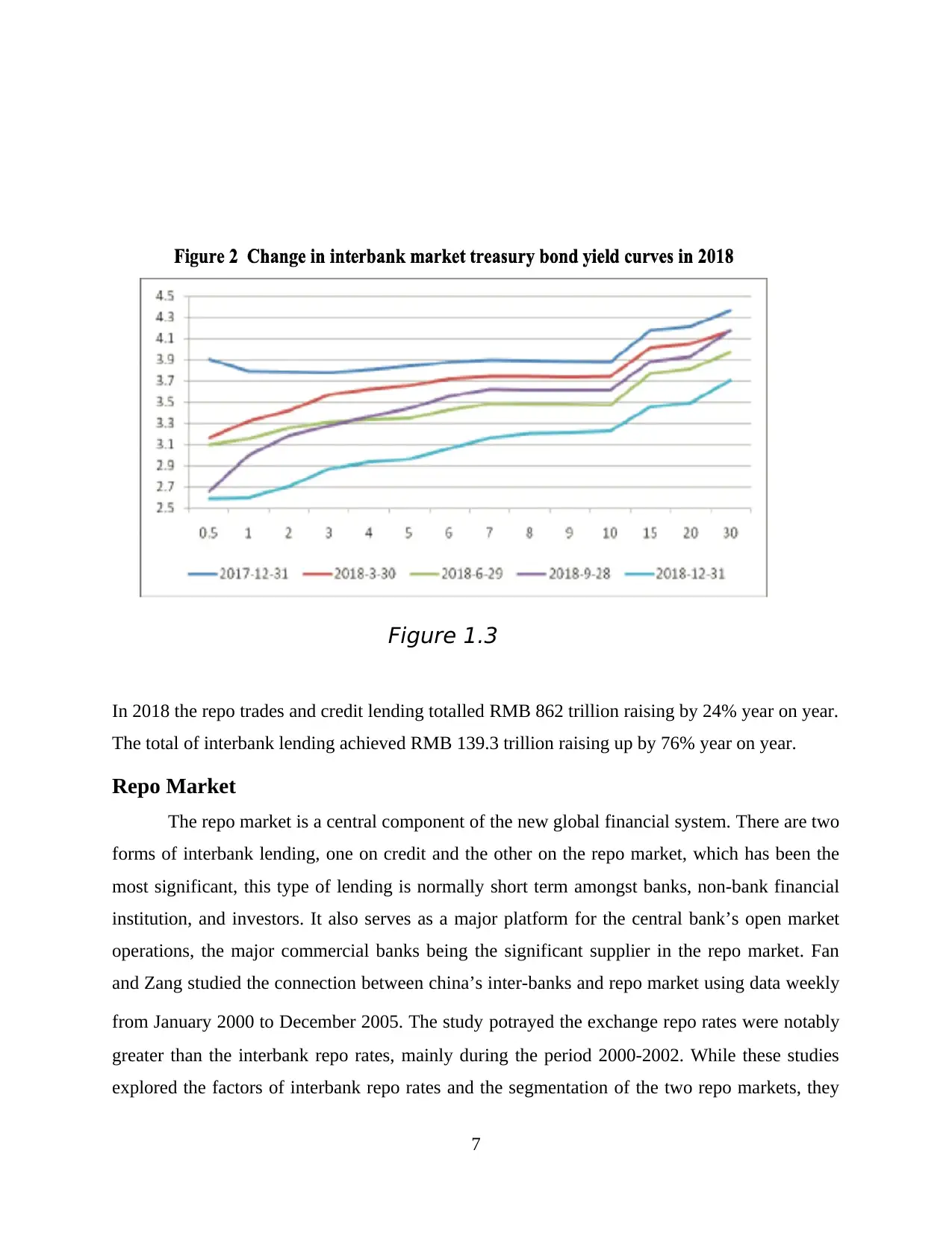
Figure 1.3
In 2018 the repo trades and credit lending totalled RMB 862 trillion raising by 24% year on year.
The total of interbank lending achieved RMB 139.3 trillion raising up by 76% year on year.
Repo Market
The repo market is a central component of the new global financial system. There are two
forms of interbank lending, one on credit and the other on the repo market, which has been the
most significant, this type of lending is normally short term amongst banks, non-bank financial
institution, and investors. It also serves as a major platform for the central bank’s open market
operations, the major commercial banks being the significant supplier in the repo market. Fan
and Zang studied the connection between china’s inter-banks and repo market using data weekly
from January 2000 to December 2005. The study potrayed the exchange repo rates were notably
greater than the interbank repo rates, mainly during the period 2000-2002. While these studies
explored the factors of interbank repo rates and the segmentation of the two repo markets, they
7
In 2018 the repo trades and credit lending totalled RMB 862 trillion raising by 24% year on year.
The total of interbank lending achieved RMB 139.3 trillion raising up by 76% year on year.
Repo Market
The repo market is a central component of the new global financial system. There are two
forms of interbank lending, one on credit and the other on the repo market, which has been the
most significant, this type of lending is normally short term amongst banks, non-bank financial
institution, and investors. It also serves as a major platform for the central bank’s open market
operations, the major commercial banks being the significant supplier in the repo market. Fan
and Zang studied the connection between china’s inter-banks and repo market using data weekly
from January 2000 to December 2005. The study potrayed the exchange repo rates were notably
greater than the interbank repo rates, mainly during the period 2000-2002. While these studies
explored the factors of interbank repo rates and the segmentation of the two repo markets, they
7
Paraphrase This Document
Need a fresh take? Get an instant paraphrase of this document with our AI Paraphraser
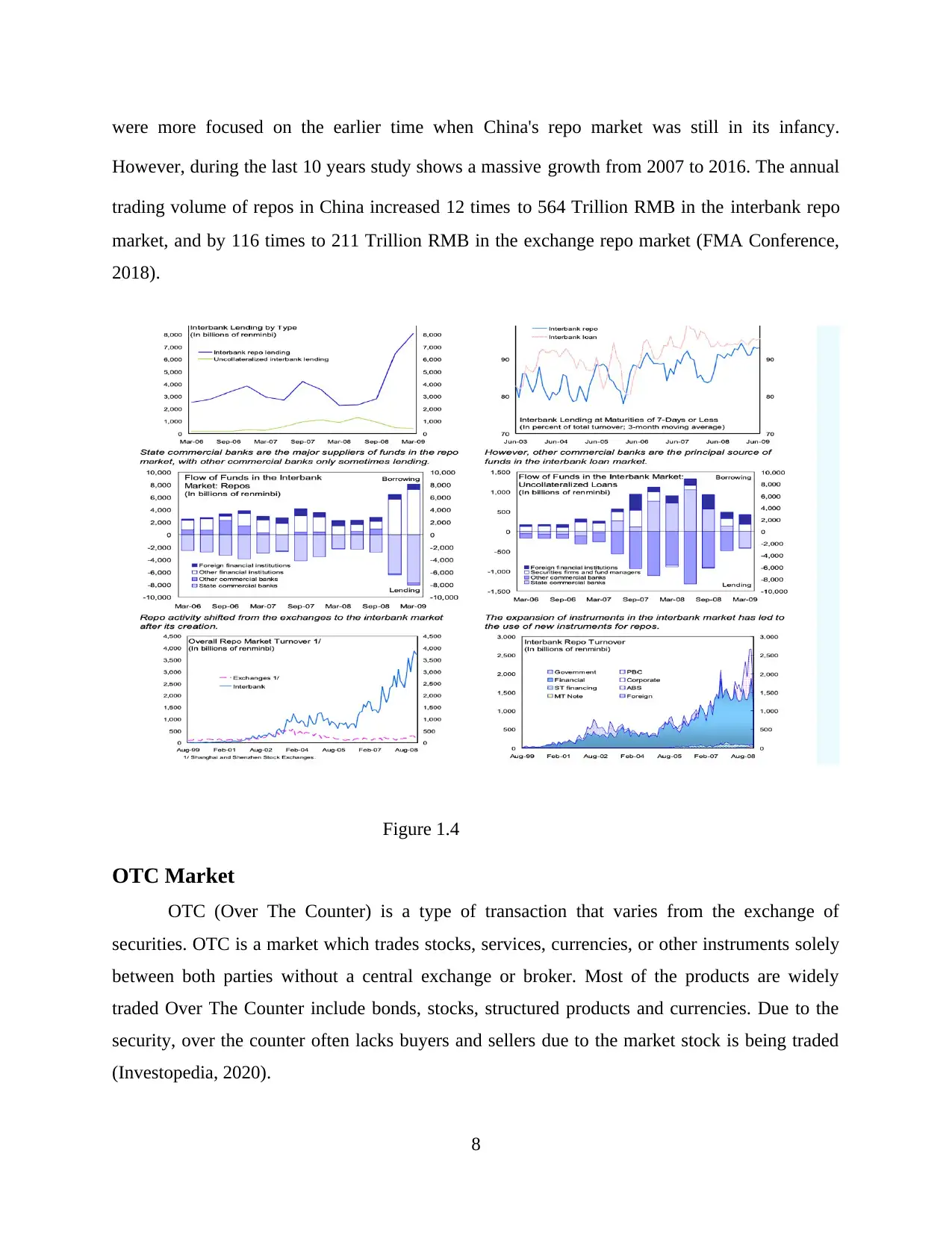
were more focused on the earlier time when China's repo market was still in its infancy.
However, during the last 10 years study shows a massive growth from 2007 to 2016. The annual
trading volume of repos in China increased 12 times to 564 Trillion RMB in the interbank repo
market, and by 116 times to 211 Trillion RMB in the exchange repo market (FMA Conference,
2018).
Figure 1.4
OTC Market
OTC (Over The Counter) is a type of transaction that varies from the exchange of
securities. OTC is a market which trades stocks, services, currencies, or other instruments solely
between both parties without a central exchange or broker. Most of the products are widely
traded Over The Counter include bonds, stocks, structured products and currencies. Due to the
security, over the counter often lacks buyers and sellers due to the market stock is being traded
(Investopedia, 2020).
8
However, during the last 10 years study shows a massive growth from 2007 to 2016. The annual
trading volume of repos in China increased 12 times to 564 Trillion RMB in the interbank repo
market, and by 116 times to 211 Trillion RMB in the exchange repo market (FMA Conference,
2018).
Figure 1.4
OTC Market
OTC (Over The Counter) is a type of transaction that varies from the exchange of
securities. OTC is a market which trades stocks, services, currencies, or other instruments solely
between both parties without a central exchange or broker. Most of the products are widely
traded Over The Counter include bonds, stocks, structured products and currencies. Due to the
security, over the counter often lacks buyers and sellers due to the market stock is being traded
(Investopedia, 2020).
8
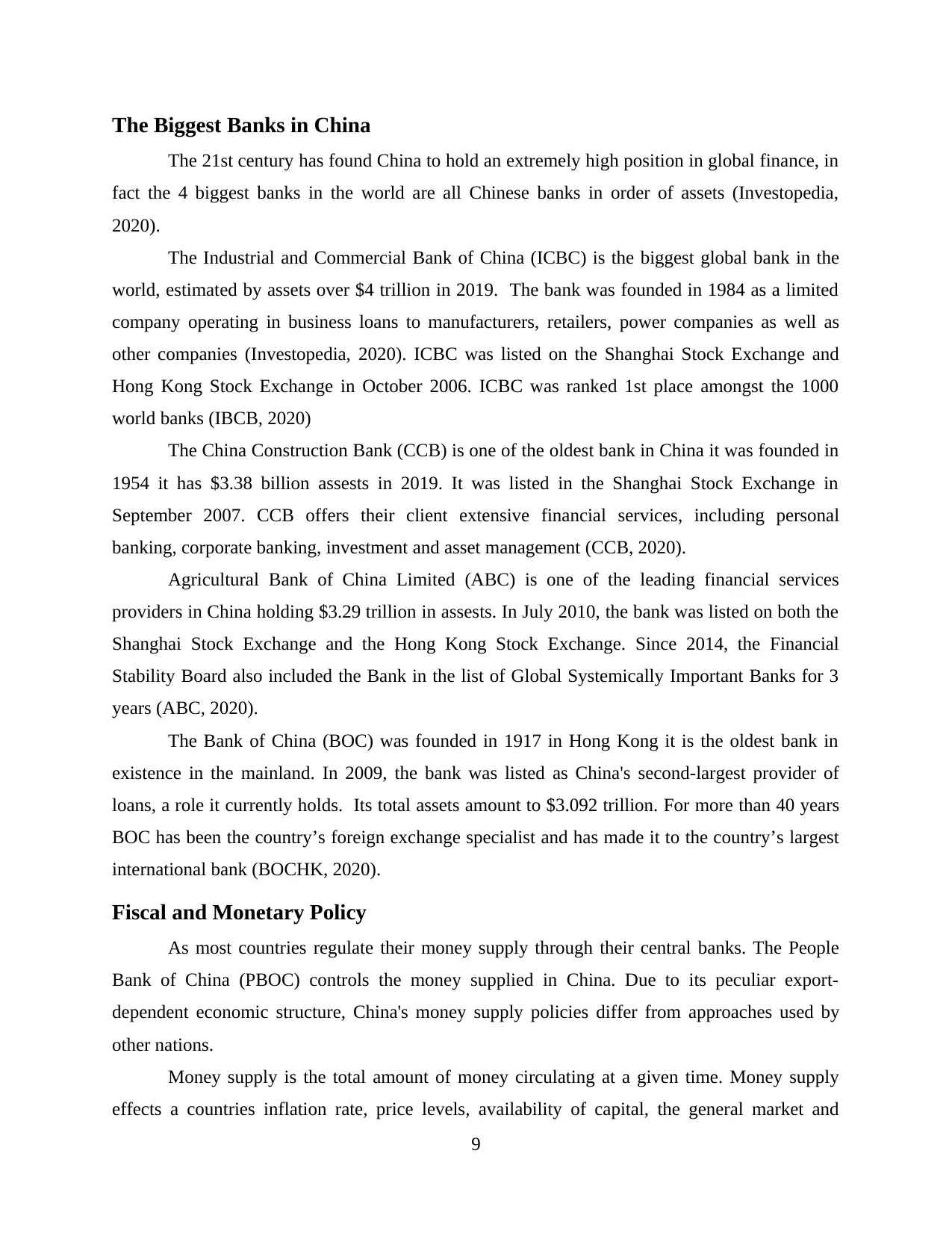
The Biggest Banks in China
The 21st century has found China to hold an extremely high position in global finance, in
fact the 4 biggest banks in the world are all Chinese banks in order of assets (Investopedia,
2020).
The Industrial and Commercial Bank of China (ICBC) is the biggest global bank in the
world, estimated by assets over $4 trillion in 2019. The bank was founded in 1984 as a limited
company operating in business loans to manufacturers, retailers, power companies as well as
other companies (Investopedia, 2020). ICBC was listed on the Shanghai Stock Exchange and
Hong Kong Stock Exchange in October 2006. ICBC was ranked 1st place amongst the 1000
world banks (IBCB, 2020)
The China Construction Bank (CCB) is one of the oldest bank in China it was founded in
1954 it has $3.38 billion assests in 2019. It was listed in the Shanghai Stock Exchange in
September 2007. CCB offers their client extensive financial services, including personal
banking, corporate banking, investment and asset management (CCB, 2020).
Agricultural Bank of China Limited (ABC) is one of the leading financial services
providers in China holding $3.29 trillion in assests. In July 2010, the bank was listed on both the
Shanghai Stock Exchange and the Hong Kong Stock Exchange. Since 2014, the Financial
Stability Board also included the Bank in the list of Global Systemically Important Banks for 3
years (ABC, 2020).
The Bank of China (BOC) was founded in 1917 in Hong Kong it is the oldest bank in
existence in the mainland. In 2009, the bank was listed as China's second-largest provider of
loans, a role it currently holds. Its total assets amount to $3.092 trillion. For more than 40 years
BOC has been the country’s foreign exchange specialist and has made it to the country’s largest
international bank (BOCHK, 2020).
Fiscal and Monetary Policy
As most countries regulate their money supply through their central banks. The People
Bank of China (PBOC) controls the money supplied in China. Due to its peculiar export-
dependent economic structure, China's money supply policies differ from approaches used by
other nations.
Money supply is the total amount of money circulating at a given time. Money supply
effects a countries inflation rate, price levels, availability of capital, the general market and
9
The 21st century has found China to hold an extremely high position in global finance, in
fact the 4 biggest banks in the world are all Chinese banks in order of assets (Investopedia,
2020).
The Industrial and Commercial Bank of China (ICBC) is the biggest global bank in the
world, estimated by assets over $4 trillion in 2019. The bank was founded in 1984 as a limited
company operating in business loans to manufacturers, retailers, power companies as well as
other companies (Investopedia, 2020). ICBC was listed on the Shanghai Stock Exchange and
Hong Kong Stock Exchange in October 2006. ICBC was ranked 1st place amongst the 1000
world banks (IBCB, 2020)
The China Construction Bank (CCB) is one of the oldest bank in China it was founded in
1954 it has $3.38 billion assests in 2019. It was listed in the Shanghai Stock Exchange in
September 2007. CCB offers their client extensive financial services, including personal
banking, corporate banking, investment and asset management (CCB, 2020).
Agricultural Bank of China Limited (ABC) is one of the leading financial services
providers in China holding $3.29 trillion in assests. In July 2010, the bank was listed on both the
Shanghai Stock Exchange and the Hong Kong Stock Exchange. Since 2014, the Financial
Stability Board also included the Bank in the list of Global Systemically Important Banks for 3
years (ABC, 2020).
The Bank of China (BOC) was founded in 1917 in Hong Kong it is the oldest bank in
existence in the mainland. In 2009, the bank was listed as China's second-largest provider of
loans, a role it currently holds. Its total assets amount to $3.092 trillion. For more than 40 years
BOC has been the country’s foreign exchange specialist and has made it to the country’s largest
international bank (BOCHK, 2020).
Fiscal and Monetary Policy
As most countries regulate their money supply through their central banks. The People
Bank of China (PBOC) controls the money supplied in China. Due to its peculiar export-
dependent economic structure, China's money supply policies differ from approaches used by
other nations.
Money supply is the total amount of money circulating at a given time. Money supply
effects a countries inflation rate, price levels, availability of capital, the general market and
9
⊘ This is a preview!⊘
Do you want full access?
Subscribe today to unlock all pages.

Trusted by 1+ million students worldwide
1 out of 17
Related Documents
Your All-in-One AI-Powered Toolkit for Academic Success.
+13062052269
info@desklib.com
Available 24*7 on WhatsApp / Email
![[object Object]](/_next/static/media/star-bottom.7253800d.svg)
Unlock your academic potential
Copyright © 2020–2025 A2Z Services. All Rights Reserved. Developed and managed by ZUCOL.





